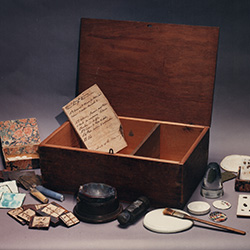 |
William Birch’s Paint Box, ca. 1780. Courtesy of the Philadelphia History Museum at the Atwater Kent, The Historical Society of Pennsylvania Collection.
Enamel painting is a painstaking technique in which a glass-like flux is mixed with mineral colors and fused to a piece of metal under extreme heat. It was hard to control the process, and the same color compound could “come from the fire very different in their seperate [sic] preparations, from the delicacy of chymical practice.”
William Birch’s paint box, which was handed down through six generations of his descendants, contained color charts (one dated 1782), bottles of powdered colors, a mortar and pestle to grind them with, dozens of blanks in various sizes, mostly copper but also brass and iron, more blanks already glazed and ready for painting, and a single paint brush. |
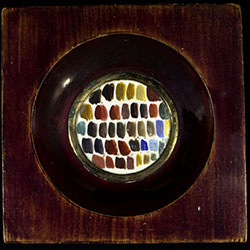 |
William Birch, Palette. Enamel. Library Company of Philadelphia.
On this enamel Birch painted samples of all the colors he used, probably keyed to recipes for each. Note the many browns and yellows. He said he was the first to paint a layer of yellow under the top layer of white to give his enamels an old-master look. He also received an “honorary pallet” from the Royal Society of Arts in 1784 for a new formula for a brown tint. |
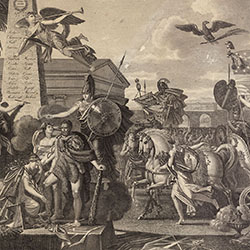 |
Chataignier, after Julia Plantou, Peace of Ghent 1814 and the Triumph of America (Philadelphia: P. Price, ca. 1817) Engraving. Library Company of Philadelphia.
Birch copied the right half of this engraving as a small enamel, which was set as a pin. It is a perfect example of the sort of drastic miniaturizing that Birch loved. The engraving was itself a copy of a (presumably even larger) oil painting commemorating the peace treaty that ended the War of 1812, by Julia Plantou, the Philadelphia historical and portrait painter. It was originally exhibited in Washington, DC in 1817. |
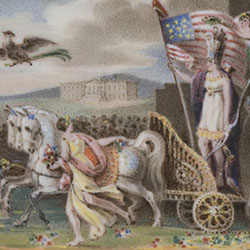 |
William Birch, Triumph of America, 1826. Enamel on copper. Courtesy of Philadelphia Museum of Art. Purchased with the Joseph E. Temple Fund, 1912.
This small enamel was copied from the right hand part of the engraving, Peace of Ghent 1814 and the Triumph of America shown in the exhibition, and was set as a pin. |
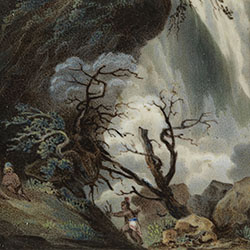 |
William Birch, Falls of Niagara, before 1827. Enamel. Courtesy of the Pennsylvania Academy of the Fine Arts. Bequest of Eliza Howard Burd.
It is doubtful Birch ever saw Niagara Falls, so this enamel must be a copy of an unidentified oil painting. |

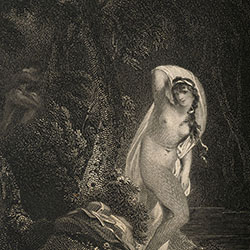
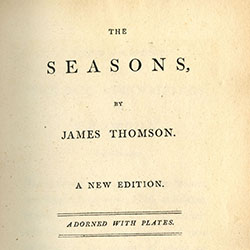
|
William Birch, after F.J. Du Roveray, Musidora, after 1802. Enamel. Courtesy of the Pennsylvania Academy of the Fine Arts. Gift of John M. Staney.
James Thomson, The Seasons (London: F.J. Du Roveray, 1802). Library Company of Philadelphia.
Once thought to be a depiction of Birch’s daughter, this enamel was in fact copied from an engraving in an 1802 edition of James Thomson’s popular early 18th century poem, The Seasons. It illustrates the moment when the swain Damon happens upon the nymph Musidora bathing. Realizing she is being watched, she freezes “in wild surprise” in the pose of the Medici Venus. |

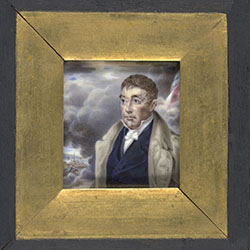
|
William Birch after Ary Scheffer, Preparatory sketch for Marquis de Lafayette portrait, 1824. Pencil sketch. Library Company of Philadelphia.
William Birch after Ary Scheffer, Marquis de Lafayette, 1824. Enamel on copper. Courtesy of the Yale University Art Gallery.
The first step in making a reduced image of a painting or a print was graphing it onto paper. This sketch of Ary Scheffer’s (1795-1858) small oil portrait of Lafayette was used to make an enamel. The lines helped Birch keep every part of the picture in proportion. He probably used the same technique to reduce or enlarge his own enamels, which he offered in a range of sizes. |
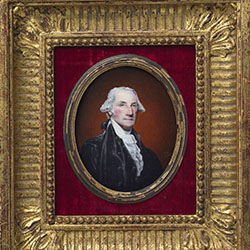 |
William Birch, George Washington, 1796. Enamel on copper. Courtesy of Philadelphia Museum of Art. Gift of the McNeil Americana Collection.
Most of the surviving enamels by Birch are copies of portraits of Washington by Gilbert Stuart (1755-1828). He began making them within weeks of his arrival in Philadelphia, and they were the means by which he made himself known to the American public. Birch often called himself a copyist as well as a miniaturist. |
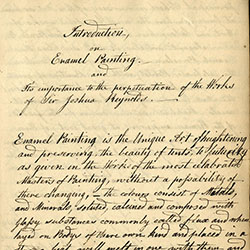 |
William Birch, The Life and Anecdotes of William Russell Birch, Enamel Painter; or the Unfortunate Traveller, ca. 1825. Manuscript. Library Company of Philadelphia.
This volume, one of several iterations of an autobiography, begins with an “Introduction on Enamel Painting.” |












